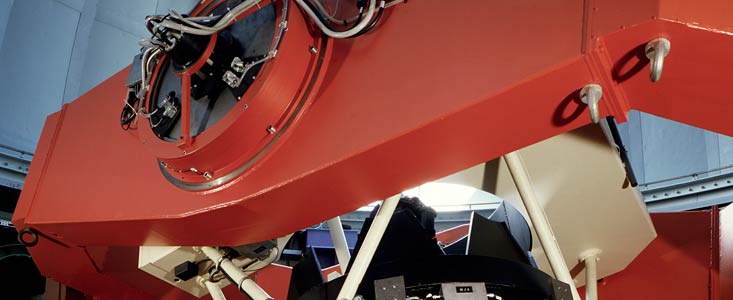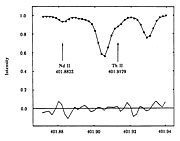Nota de Imprensa
Is the Universe Younger than Previously Thought?
3 de Julho de 1987
The first observations of a long-lived radioactive isotope outside the Solar System indicate that the Universe may be younger than previously thought. Using one of the world's most powerful spectrometers, located at the ESO La Silla observatory in Chile, Professor Harvey R. Butcher of the University of Groningen, The Netherlands, has detected for the first time the radioactive element Thorium-232 in stars. A comparison of its abundance in old and young stars failed to show the expected differences. This means that the total age of Thorium-232 in these stars must be smaller than about 10 Gyr [1], instead of the previously estimated 16 - 18 Gyr.
Three clocks are used by scientists to estimate the minimum age of the Universe. The first of these relies on age-dating of certain stars by comparing their observed properties (temperature, luminosity, mass) with theoretical calculations; by this technique the oldest stars found to date, mostly in globular clusters, have been estimated to be over 16 Gyr old.
The second method is more straightforward. Galaxies are observed to be flying apart in the so-called Hubble expansion of the Universe; by extrapolating the observed velocities backwards, it is found that the galaxies would have been very near each other between 10 and 20 Gyr ago.
And third, the radioactive decay of certain isotopes in meteorites age-dates the chemical elements in the Solar System. The maximum age so derived depends on whether the elements were synthesized all at one time or more or less uniformly during a long time span. The resulting estimates range from 7 to 22 Gyr.
Given the substantial uncertainties in the latter two clocks, preference has been given to the stellar technique. A widely accepted minimum age of the Universe has therefore been around 16 - 18 Gyr.
The new observations of objects far outside the Solar System for the first time permit the radioactivity clock to be analyzed independently of the history of element synthesis. The half-life of the radioactive isotope Thorium-232 is 14 Gyr, making it sensitive to synthesis events over the whole of the age of the Universe. This Thorium isotope is the only one that occurs naturally and it decays by emitting an α-particle. Combining the meteoritic and the new stellar data now indicates that the observed Thorium-232 is very unlikely to be much older than about 10 Gyr. The unexpected, but unavoidable conclusion is therefore that the theoretical stellar age estimates must be in error.
The new analysis required measurement of exceedingly weak spectral absorption features of Thorium-232 in a sample of solar-type stars of different ages in the Milky Way Galaxy. The accuracy needed for this spectral study was substantially greater than what is generally attainable on faint stellar sources. The spectra were registered with the ESO-built Coudé Echelle Spectrometer which was fed by light collected at the 1.4 m Coudé Auxiliary Telescope on La Silla. In order to separate the features from the spectral lines of other elements, a very high spectral resolution had to be used, necessitating long integration times. In the end, data for twenty stars with widely different ages were obtained during two observing runs.
Professor Butcher adds: “These observations were only possible because of the superlative quality of the ESO spectrometer. I don't think it will be possible to improve on these data, and actually to measure an accurate history of element synthesis, until the new ESO Very Large Telescope is in operation, during the late 1990's."
Informações adicionais
This work will be published in the July 9, 1987 issue of the scientific journal Nature.
Three photos, which illustrate the subject of this Press Release, are available on request from the ESO Information and Photographic Service:
Colour picture of the ESO 1.4 Coudé Auxiliary Telescope (CAT)
Colour picture of the Coudé Echelle Spectrometer (CES)
Graphic representation of a part of the spectrum of the old star HR 509, showing lines of ionized Thorium and Neodymium, near 401.90 nm.
Contactos
Richard West
ESO
Garching, Germany
Tel.: +49 89 3200 6276
Email: information@eso.org
Sobre a Nota de Imprensa
| Nº da Notícia: | eso8710 |
| Legacy ID: | PR 10/87 |
| Nome: | Coudé Auxiliary Telescope, HR 509, Instrumentation |
| Tipo: | Local Universe : Cosmology |
| Facility: | Coudé Auxiliary Telescope |
| Instrumentos: | Coudé Echelle Spectrometer (CES) |



